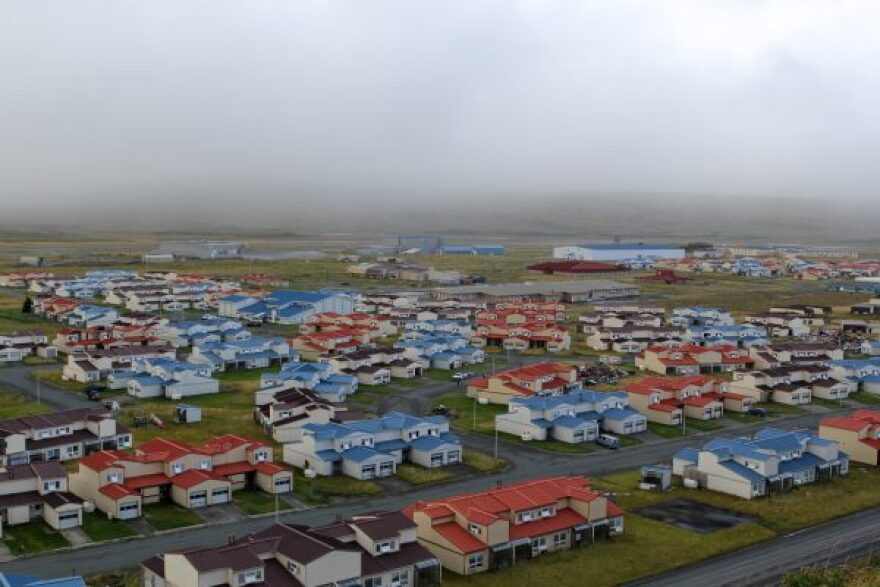Amid the wind, waves, and rain, a strange ship roared through Kuluk Bay toward the shores of Adak.
It looked out of place, speeding past misty green mountains of the western Aleutian Island, a cross between a speedboat and an industrial fishing barge. With alarming speed, it lurched from the shore onto the beach, kicking up dark swirls of sand and sea spray. Its cargo trickled down of a ramp: Humvees, U.S. Marines, a compact green bulldozer. Everything you would need in an invasion.
For the first time in more than 30 years, the U.S. Navy and Marine Corps have held large-scale exercises in the Aleutians designed to test their capabilities in a cold-climate environment. It's been more than two decades since the Pentagon shuttered a large naval airbase on the island that once housed 6,000 service members and their families.
Now, with Arctic sea ice melting, shipping traffic increasing, and shifting defense priorities, the military is weighing whether it wants to return to Alaska's Bering Sea.
One of the biggest boosters for that idea is the Aleut Corporation, an Alaska Native regional corporation that owns much of Adak's land. The corporation sees in the military a potential anchor tenant on an island that could transform into a hub for trans-polar shipping in the coming decades.

But on a rainy morning this September, Rear Admiral Cedric Pringle's concerns were more immediate: Would the weather let up enough for the training to even happen?
"You can't simulate this," said Pringle from the beach as he was hit with wind strong enough to make his eyes water.
The day before, powerful gales and low cloud ceiling led military leaders to postpone their plan to have Marine battalions storm the beach as attack helicopters helped seize a nearby airfield. Though the conditions are normal for the western Aleutians, it was enough to scramble a planned visit by Navy Secretary Richard Spencer.

Pringle is in charge of 15,000 seamen and marines, many of whom were seeing Alaska for the first time as part of the Arctic Expeditionary Capabilities Exercise.
"From a Navy-Marine stand point, we looked at this exercise as an opportunity to conduct training in a very, very challenging environment," said Pringle.
They also worked with the U.S. Coast Guard, which has a more consistent presence in Alaska and was helping train infantry Marines in search and rescue operations.

More broadly, the exercise was a chance for the military to assess whether moving large numbers of troops and supplies from a warship out in the ocean onto shore would work in an environment much further north than the Navy is accustomed to.
"That's exactly what we'd do with a combat situation," said Pringle. "That's exactly what we would do in a humanitarian situation, as well."
As part of the same exercise, a concurrent operation in Seward tested a bulk liquid transfer from ship to shore, the sort of technique that would allow you to transfer fuel to a devastated port.
A few hours after Pringle departed, the LCAC's landed on Adak's shores. "Landing Craft, Air Cushion" vehicles are airboats powered by massive industrial fans that float above the waves on an inflatable cushion the size of a basketball court. They are loud and fast, designed to ferry equipment from warships after infantry troops establish beachheads.

A delegation from the Aleut Corporation watched the LCACs from the shore.
"The Aleut Corporation is very pleased that the military is here," said CEO Thomas Mack. "And we look forward to a continued relationship."
The corporation is hoping the Navy will reestablish some kind of permanent presence on the island, whether that's basing personnel here or regularly conducting trainings. It sees Adak as offering the military an advantageous strategic location.
"With the opening of the Arctic, with the different things that are going on geopolitically in the world, Adak is in a place that the U.S. needs to utilize," said Mack. "And we want to be a part of that."

What makes Adak different from other Alaska communities lobbying for military assets — and the federal dollars they bring — is that almost every building on the island once belonged to the Defense Department. Adak was a staging point for the American military's Aleutian campaign during World War II.
During the Cold War, the Navy maintained an anti-submarine base on the island, with thousands of people living in pre-fabricated houses and blocky barracks. In the 1990s, the federal government closed its base. Under a transfer agreement, the Aleut Corporation purchased most of the military's land and facilities.
Now, a small permanent civilian population — between 100 and 300, depending on the time of year — lives on the island, many of whom work at a fish processing plant. But the remnants of a much larger, semi-abandoned community remain all around.
From a ridgeline above the beach, you can stare out at suburban-style cul-de-sacs filled mostly with vacant houses, many of which are partially destroyed from the scouring winds. Roads crisscross the rolling mountains. Up in the hills are crumbling concrete barracks and rusting power stations. There's an old McDonald's boarded up not far from a daycare building that now houses a small grocery store.
This large imprint is a problem for Adak's viability as a town. Paul Fuhs is the military liaison for the Aleut Corporation, and he said that if Navy came back, it would go a long ways toward reviving the town.

"They would be an anchor tenant," said Fuhs. "One of the challenges for the community here is that the base was so big before that all the utilities are on too large a scale to operate."
If the military returned, it would convert what are liabilities for the local government and Aleut Corporation into opportunities for national defense, according to Fuhs. Dilapidated barracks in the hills could be used for urban warfare training, for example, instead of sitting empty and unused.
The sub-Arctic environment, which threw the exercise's timelines into disarray, is another selling point.
"When you're in a war, you don't get to pick your weather," said Fuhs. "It's a challenge. They want to challenge their troops."
Weather is hardly the only barrier for increased activity. Adak is 444 miles from the nearest population hub, Unalaska, and more than 1,200 miles from Anchorage. But with melting Arctic sea ice, the corporation envisions a possible cargo shipping hub on Adak that could serve vessels transiting the Northern Sea and Trans-Polar routes.
If they can get the military committed to increasing its presence, that might bring compounding benefits from rising commercial interest in the island.

"We've done everything that we can to show them that they'd be welcome here and that we're ready to facilitate anything that they want to do," said Fuhs.
Asked whether the Navy has plans to reestablish a permanent presence on Adak, Navy 3rd fleet spokesperson Lieutenant Rochelle Rieger said, "Potential basing in Alaska is something the Navy is looking at, but the specifics are pre-decisional at this point."
In the meantime, the military and policymakers have to figure out where Alaska fits in the country's approach to national defense and a warming planet.
This story was originally published at Alaska Public Media. It's shared here with permission.





